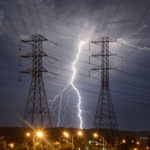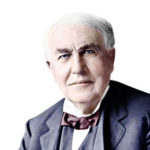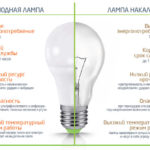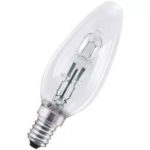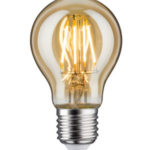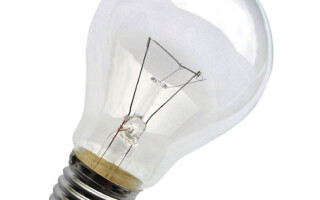History has preserved for us the names of those who invented the incandescent light bulb and worked on her initial models. The path of creating the most useful invention of the late 19th century is interesting and unusual. Today, artificial lighting in the house is a common thing. But many years have passed since the electric lamp acquired its familiar appearance and was put on the production line.
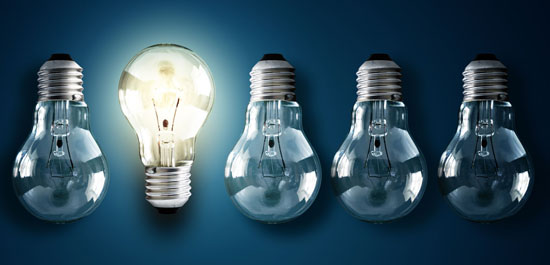
Content
Timeline of invention
History of the incandescent lamp begins in the 19th century. About 50 years remained before the introduction of a useful invention to the world. However, the English scientist Humphrey Davy in his laboratory had already conducted experiments with the incandescence of conductors with an electric current. Yet he was not the one who invented the light bulbsuitable for illumination. For two decades, a number of leading European and American physicists have tried to improve Humphry Davy's experience by heating metal and carbon conductors.
German watchmaker Heinrich Goebel was the first who came up with a lamp with incandescent elements, using the method of manufacturing barometers. The invention was presented in 1854 at an exhibition in New York. The design itself was made of cologne bottles and glass tubes, in which Goebel made with mercury vacuum. Inside he placed a charred bamboo thread, which in flask pumped out air could burn up to 200 hours.
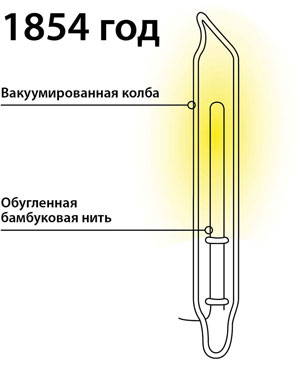
Since 1872 in St. Petersburg, work on lamp Incandescence is started by Russian electrical engineers A. N. Lodygin and V. F. Didrikhson. Between the thick copper rods they placed a thin coal stick. For this invention, A. N. Lodygin received the Lomonosov Prize. In 1875, V. F. Didrikhson changed the charcoal stick to a wooden one. A year later, a naval officer and talented inventor N. P. Bulygin improved the design invented by compatriots. Outwardly, it almost did not change, however, due to the coating of carbon rods with a layer of copper, the current strength increased.
Many people think inventor Thomas Edison's first lamp. However, before the device fell into the hands of the American inventor, scientists in five European countries already had a patent for it. AT what year Edison began his development of electric lighting, it is not known exactly.
In the 70s of the XIX century bulb Lodygina came to the USA. Thomas Edison brought nothing new to the structure of the Russian inventor, however, he came up with a design superstructure: a cartridge and a screw base, switches and fuses, an energy meter.With the work of Edison begins industrial invention history.
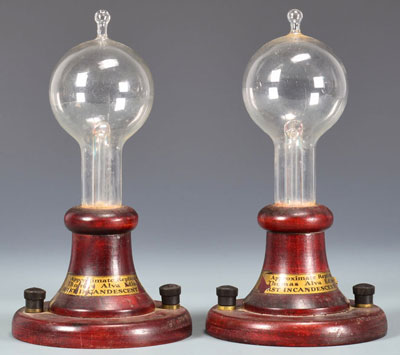
The first transformations of energy into light
appearance first incandescent lamp preceded by the greatest event of the eighteenth century - the discovery of electric current. He was the first to investigate electrical phenomena and tackled the problem of obtaining current from different metals and chemicals Italian physicist Luigi Galvani.
In 1802, the Russian experimental physicist V. V. Petrov designed a powerful battery and with its help received an electric arc that could produce light. However, the disadvantage of Petrov's discovery was the too rapid burnout of charcoal, which was used as an electrode.
The first arc lamp capable of burning for a long time was designed by the Englishman Humphry Davy in 1806. He experimented with electricity, invented the electric light bulb with carbon rods. However, it shone so brightly and unnaturally that there was no use for it.
Incandescent lamp: prototypes
Invention of the incandescent lamp attributed to several scholars. Some of them worked at the same time, but in different countries. Scientists who worked at a later time made significant improvements to the inventions of their predecessors. In this way, creating an incandescent lamp is the work of several people.
Direct development of structures with incandescent elements began in the 30s of the XIX century. The Belgian scientist Jobar introduced the world to the first design with a carbon core. His charcoal lamp did not receive a wide calling only because it burned for no more than 30 minutes. However, this was progress at the time.
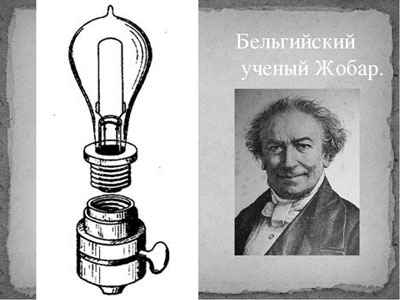
At the same time, the English physicist Warren de la Rue presents his lamp with a platinum element in the form of a spiral. Platinum shone brightly, and vacuum inside glass flasks allowing it to be used in all weather conditions. The invention of Warren de la Rue became the prototype of other designs, although it itself did not receive further development due to its high cost.
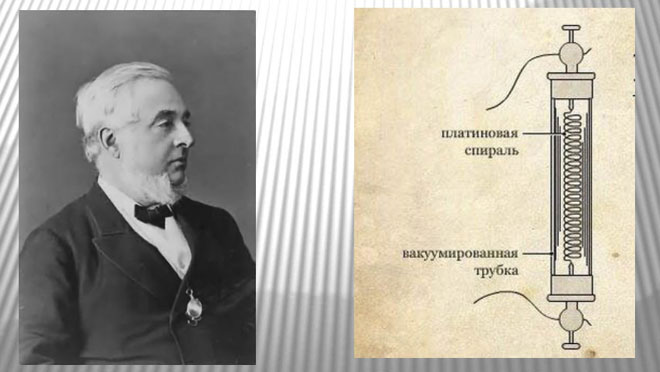
Another English physicist, Frederick de Molayne, slightly changed the brainchild of de la Rue by installing platinum threads instead of a spiral. However, they quickly burned out. A little later, physicists King and John Starr improved the design of English colleagues. The Englishman King replaced platinum threads with coal sticks, increasing the duration of their burning. And the American John Starr came up with a design with a carbon burner and a vacuum sphere.
First results
The first Light source appeared in Heinrich's workshop Goebel. He was not professional inventor, however opened first world incandescent lamp. Goebel installed lighting fixtures in his watch shop and equipped a stroller with them, where he invited everyone. However, due to lack of funds Goebel failed to obtain a patent for his invention. Only at the end of the life of the German watchmaker recognized inventor incandescent lamps.
First in Russia inventor designs with incandescent elements became A. N. Lodygin. Together with his colleague V. F. Didrikhson, he initiated the electric lighting of St. Petersburg. The first coal lighting structures, created by Russian inventors, were installed in the St. Petersburg Admiralty.A year later, artificial light appeared in some shops in the capital and on the Alexander Bridge.
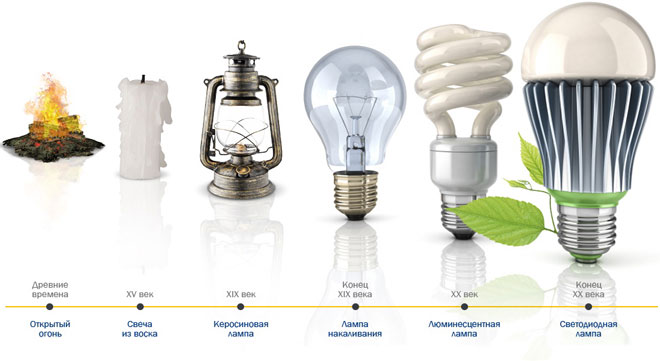
Fight for patents
Since work on the creation of electric light sources was carried out in many countries, several scientists received patents for similar inventions at once. However, in the United States, the multiple discovery led to a patent fight for the incandescent lamp.
For primacy in the ownership of electrical light bulb fought 2 venerable inventor - Englishman Joseph Swan and American Thomas Edison. Englishman patented the charcoal lamp fiber, which began to be used in industrial production in the British Isles. Thomas Edison worked on improving Alexander Lodygin's filament lamp. As threads, he tried many metals and settled on carbon fiber, bringing the lamp's burning time to 40 hours.
Joseph Swan sued an American colleague for copyright infringement, so the lamp presented by Edison was subsequently called the Edison-Swan lamp. When later bamboo fibers were brought from Japan, the duration of which reached 600 hours of burning, scientists were again in court, as they began to use this material in their inventions. The matter ended with the fact that Edison and Swan founded a joint company for the production of electrical light bulbs, which quickly became a world leader.
Metal filaments
Instead of candles, charcoal incandescent lamps appeared. And then the structure was equipped with metal threads.At the end of the 19th century, the German physicist Walter Nernst made a special alloy for the production of filaments. It included such metals as:
- yttrium;
- magnesium;
- thorium.
At the same time, A.N. Lodygin invents a rapidly heated tungsten filament. However, later the Russian inventor sold his discovery to a company founded by Thomas Edison. Tungsten filaments ushered in a new era of electric lighting.
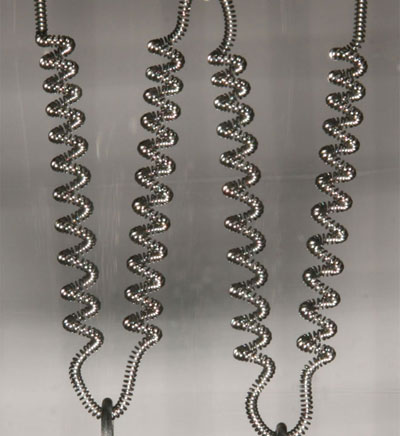
Further inventions
Until the 20th century, interest in electric lighting among scientists was not so high. However, with the advent of the new millennium, everything has changed. The twentieth century is characterized by a whole wave of inventions of various electric lamps. In 1901 the American inventor Peter Hewitt introduced the mercury lamp to the world. And in 1911, the French chemist Georges Claudi created a neon lamp.
In the first half of the 20th century, designs such as xenon, fluorescent and sodium lamps appeared. In the 60s, the world saw LED lamps capable of illuminating large rooms. And in 1983, economical fluorescent lampsthat reduce energy consumption. However, the future lies with fluorescent designs that have appeared recently. They can not only save energy, but also clean air.

